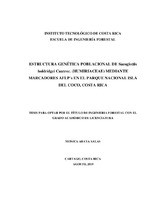| dc.contributor.advisor | Rojas-Parajeles, Fabiana | es |
| dc.contributor.author | Araya-Salas, Mónica | |
| dc.date.accessioned | 2020-03-17T00:31:05Z | |
| dc.date.available | 2020-03-17T00:31:05Z | |
| dc.date.issued | 2019 | |
| dc.identifier.uri | https://hdl.handle.net/2238/11193 | |
| dc.description | Trabajo Final de Graduación (Licenciatura en Ingeniería Forestal) Instituto Tecnológico de Costa Rica, Escuela de Ingeniería Forestal, 2019. | es |
| dc.description.abstract | Sacoglottis holdridgei es la especie leñosa de mayor importancia en la ecología de los bosques del Parque Nacional Isla del Coco. A pesar de ser una especie endémica perteneciente a un ecosistema insular oceánico, no existen registros genéticos que evalúen su estado en el tiempo; lo cual, limita la capacidad de intervenir en su manejo y conservación a largo plazo. Por tanto, el objetivo principal de este estudio fue analizar la estructura de dos subpoblaciones naturales definidas por su rango altitudinal (P1=Bosque Pluvial Premontano/ P2=Bosque Nuboso), mediante la aplicación de la técnica de AFLP’s (Polimorfismos en la Longitud de Fragmentos Amplificados). Para ello, se colectó tejido foliar fresco de 70 individuos y se extrajo su ADN nuclear, mediante la combinación del protocolo CTAB y el protocolo DNeasy Plant Mini Kit de la casa comercial QIAGEN™. Las subpoblaciones fueron evaluadas con 12 combinaciones de imprimadores selectivos, de las cuales finalmente se seleccionaron siete (E-ATC/M-CAC, E-AGG/M-CAG, E-ATC/M-CAG, E-ATC/M-CTT, E-ATC/M-CGG, E-ACG/M-CTA y E-AGC/M-CTA), que permitieron el análisis de 122 fragmentos. Un 78,69% de los fragmentos resultaron polimórficos. La diversidad genética promedio fue de 0,201 (P1=0,205; P2=0,197). El análisis AMOVA mostró que la mayor variación genética se da dentro de subpoblaciones (97%). Asimismo, el análisis PCoA y el análisis de agrupamiento bayesiano, afirmaron la existencia de dos subpoblaciones relacionadas genéticamente que presentan una tendencia a una futura separación por la acción del tiempo y evolución. Se determinó que el grado de diferenciación genética entre poblaciones es escaso; lo cual indica que el flujo genético es de moderado a alto. | es |
| dc.description.abstract | Sacoglottis holdridgei is the most important woody species in the ecology of the forests of Isla del Coco National Park. Despite being an endemic species belonging to an insular oceanic ecosystem, there are no genetic records that evaluate its status over time; which limits the ability to intervene in its management and long-term conservation. Therefore, the main objective of this study was to analyze the genetic structure in two natural subpopulations defined by their altitudinal range (P1 = Premontane Pluvial Forest / P2 = Cloud Forest), through the application of the AFLP’s technique (Polymorphisms in the Length of Amplified Fragments). To do this, fresh foliar tissue from 70 individuals was collected and its nuclear DNA extracted, by combining the CTAB protocol and the commercially available DNeasy Plant Mini Kit from QIAGEN ™. The populations were evaluated with 12 combinations of selective primers, from which seven were selected (E-ATC / M-CAC, E-AGG / M-CAG, E-ATC / M-CAG, E-ATC / M-CTT, E-ATC / M-CGG, E-ACG / M-CTA and E-AGC / M-CTA), these allowed the analysis of 122 fragments. The 78,69% of the fragments were polymorphic. The average genetic diversity obtained was 0.201 (P1 = 0,205; P2 = 0,197). The AMOVA analysis showed that the greatest genetic variation occurs within subpopulations (97%). Likewise, the PCoA analysis and Bayesian grouping analysis, affirmed the existence of two genetically related subpopulations that present a tendency to a future separation by action of time and evolution. It was determined that the degree of genetic differentiation among populations is scarce; which indicates that the genetic flow is moderate to high. | es |
| dc.description.sponsorship | Vicerrectoría de Investigación y Extensión del Instituto Tecnológico de Costa Rica (VIE) y al Sistema Nacional de Áreas de Conservación (SINAC). | es |
| dc.language.iso | spa | es |
| dc.publisher | Instituto Tecnológico de Costa Rica | es |
| dc.rights | Attribution-NonCommercial 4.0 International | * |
| dc.rights.uri | https://creativecommons.org/licenses/by-nc/4.0/ | * |
| dc.subject | Estructura genética | es |
| dc.subject | Parque Nacional Isla del Coco | es |
| dc.subject | Especies leñosas | es |
| dc.subject | Polimorfismos en la longitud de fragmentos amplificados (AFLP's) | es |
| dc.subject | Genetic structure | es |
| dc.subject | Isla del Coco National Park | es |
| dc.subject | Woody species | es |
| dc.subject | Polymorphisms in the Length of Amplified Fragments (AFLP's) | es |
| dc.subject | Research Subject Categories::FORESTRY, AGRICULTURAL SCIENCES and LANDSCAPE PLANNING::Area technology::Forest engineering | es |
| dc.title | Estructura genética poblacional de Sacoglottis holdridgei Cuatrec. (Humiriaceae) mediante marcadores AFLP’s en el Parque Nacional Isla del Coco, Costa Rica | es |
| dc.type | licentiateThesis | es |



